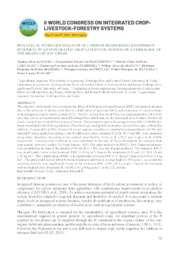Biological nitrogen fixation of common beans reduces emission intensity in an integrated crop-livestock system on a Ferralsol of the brazilian savannah.
Biological nitrogen fixation of common beans reduces emission intensity in an integrated crop-livestock system on a Ferralsol of the brazilian savannah.
Author(s): SOUSA, A. A. de; NASCIMENTO, F. P. de; CARVALHO, M. T. de M.; FERREIRA, E. P. de B.; ARAÚJO, W. A. de; SIQUEIRA, M. M. de B.; FREITAS, W. F. de; SILVEIRA, P. M. da; MADARI, B. E.
Summary: The objective of the study was to evaluate the effect of biological nitrogen fixation (BNF) and mineral nitrogen (N) on the emission of nitrous oxide (N2O), volatilization of ammonia (NH3) and production of common beans in an integrated crop-livestock system (ICL). The ICL system has about 8 ha, was implemented in 2011/2012 on a clay soil in an experimental area of Embrapa Rice and Beans, in the municipal area of Santo Antônio de Goiás, Goiás State, Central West region of Brazil. The treatments were without application of N (CONTROL); beans inoculated with N-fixing bacteria (Rhizobium sp.) and growth promoters (Azospirillum sp.), without the addition of mineral N (BNF); Mineral N (urea) applied according to standard recommendation (65 N); and mineral N (urea) applied according to the N sufficiency index criterion (102 N). N2O and NH3 were measured using static chambers, according to the method described by Alves et al. (2012) and Araújo et al. (2009), respectively. Emission and volatilization were calculated as the sum of fluxes throughout the common bean crop season, between October 2019 and January 2020. The cultivar used was BRS FC104. Emission intensity was calculated as the sum of the amount of N lost (N2O + NH3) per kg of grain produced. The emission of N2O was significantly lower in the treatment BNF (0.69 kg ha-1) than in the treatments 65 N and 102 N (1.44 and 1.25 kg ha-1). The volatilization of NH3 was significantly lower in BNF (1.31 kg ha-1) than in 102 N (11.38 kg ha-1). The grain yield did not differ between treatments and was in average high (3,109 kg ha-1), as a result the emission intensity was significantly lower in the treatment BNF (0.90 g N kg grain-1) than in the treatment with the highest dose of mineral N, 102 N (3.86 g N kg grain-1) in the ICL system.
Publication year: 2021
Types of publication: Paper in annals and proceedings
Unit: Embrapa Rice & Beans
Observation
Some of Embrapa's publications are published as ePub files. To read them, use or download one of the following free software options to your computer or mobile device. Android: Google Play Books; IOS: iBooks; Windows and Linux: Calibre.
Access other publications
Access the Agricultural Research Database (BDPA) to consult Embrapa's full library collection and records.
Visit Embrapa Bookstore to purchase books and other publications sold by Embrapa.

